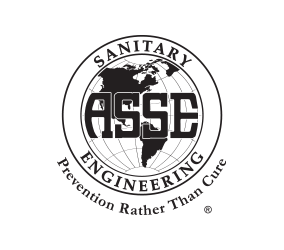| Contact Information |
Name, company (if applicable), and commenter’s email address |
|
| Issues Related to LEC Verbiage and Scope |
Health and safety issues and any technical issues related to the LEC verbiage and scope |
|
| Evidence and Supporting Information |
Any evidence and information to support the comments. All attachments must be submitted in PDF or Microsoft Office format |
|
| Alternate Text |
Alternate text in order to resolve the issue of concern with the public’s health and safety as a priority |
LISTING EVALUATION CRITERIA
ASSE recognizes the importance and benefits of input from a variety of industry stakeholders in order to develop the best standards and performance documents. Listing Evaluation Criteria (LEC) are Other Recognized Documents (ORD’s) that establish the initial rules for unique products in the marketplace. An LEC is an opportunity for new devices to gain a footing in the marketplace when combined with 3rd-party certification.
An LEC is valid for 5 years from publication date. At that point, the ASSE Product Standards Committee (PSC) will observe its market acceptance and decide the appropriate route for it in partnership with the original requester. All public comments are reviewed after the end of the 20-day public review period by the PSC and are resolved to the best ability of the PSC and the commenter.
Comments must include the following:
Submit public comments to staffengineer@asse-plumbing.org with the name of the LEC in the subject.
RELEASED AND AVAILABLE
| Designation | Title | Released | Description |
| Shower Filtration Fitting for Reduction of Chloramine | Feb 2017 | Devices are shower filters are designed to reduce contaminants typically found in potable water supply lines, such as chlorine and chloramine. The product improves the showering experience by reducing aesthetic contaminants from supply water. | |
| Point of Entry Reverse Osmosis Systems | Sept 2019 | This covers contaminant reduction claims for POE RO systems used to treat drinking water. RO water treatment equipment reduce total dissolved solids, heavy metals, microbes, inorganics, and organic water contaminants. POE ROs are typically installed after the water meter in residences or businesses. | |
| Point of Entry Anion Exchange – Nitrate Reduction | Feb 2021 | The water treatment systems covered in this ASSE LEC 2008 shall be self-regeneration anion exchange systems designed to reduce nitrate from drinking water. The systems shall use anion exchange media that prevents nitrate dumping. Depending on the influent water quality, anion exchange systems, if not regenerated correctly, can dump or increase the amount of nitrate in the drinking water if other anions such as sulfates are exchanged by the resin. Non-regenerating residential water treatment systems designed to reduce nitrates shall be tested to NSF/ANSI 53. | |
| Legionella Reduction and Treatment Devices | Aug 2022 | Legionella reduction and treatment devices are designed to reduce the microorganisms in the genus Legionella (e.g., Legionella pneumophila) typically found in potable water systems. The devices reduce the number of the bacteria through inactivation and/or filtration. They can reduce or prevent the downstream bacterial colonization of a water system and thus ultimately the release of the bacteria into the product water. Devices are intended to be used at Point of Entry (POE) or Point-Of-Use (POU) in applications for hot or cold-water or both for drinking water, washing hands or showering. The device reduces the quantity of Legionella bacteria that exit the device. Major components may include a disinfecting chemical inlet, mixing chamber, thermal element, housing, filtration media, and ultraviolet (UV) light source. The performance requirements in this standard are for full systems and are not intended to apply to components (i.e., filters). |
If you have a product that does not quite fit the mold of an existing standard or would like to know more about the process of developing an LEC and whether it is appropriate for you, please contact us at staffengineer@asse-plumbing.org.
